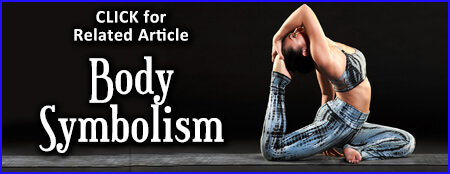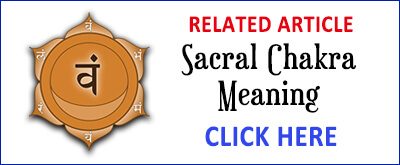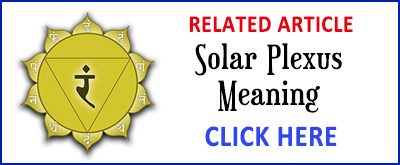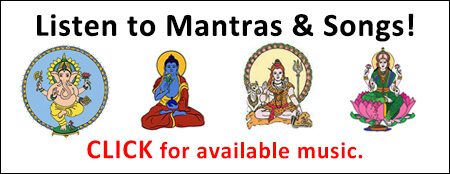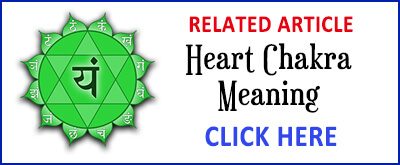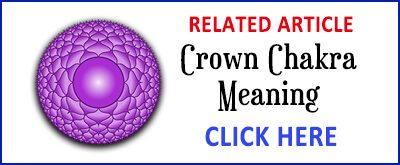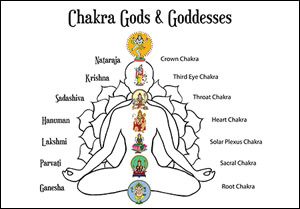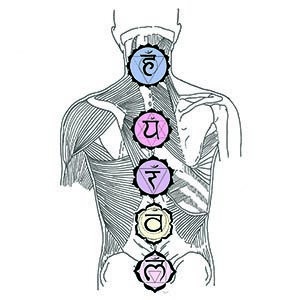
Chakras and Corresponding Organs
Each of the organs in the human body are associated with one or more of the seven major chakras or energy centers. This connection gives keys to creating optimal health on both energetic and physical levels. The chakras and their corresponding organs can be stimulated and balanced through the use of mantras, acupuncture, meditation, visualization, herbs, yoga practice, and other forms of exercise.
Body Organs from the Root Chakra to the Crown
This article will cover the seven chakras in the body and the associated organs starting with the root chakra and moving upward to the crown chakra. We’ll look at the location of the chakras, the functions of the chakras, and the roles of the nearby organs. We’ll also explore the body systems related to the chakras as well as the psychological and emotional connections.
More Chakra Resources
In addition to the connections between the chakras and organs of the body, there are sounds and musical instruments that resonate with each chakra. More information can be found in Chakra Sounds. Furthermore, there are healing stones and crystals that connect to each chakra. See Chakra Stones and Meanings. For more information about the spiritual meaning of various aspects of the human body, see the article Body Symbolism.
Table of Contents
Share this page with a friend!
ROOT CHAKRA and Associated Organs
The root chakra governs the lower part of the body, including the legs, hips, lower back and lower spine. These areas of the body establish balance and stability. The root chakra also governs the organs of elimination including the colon and bladder. These are the organs and systems that provide a strong foundation for physical health and a platform for our presence in the world.
Role of the Root Chakra
The root chakra is the place where we process and transform energy, thoughts, and experiences related to security, safety, and personal and ancestral history. The root chakra is connected to the earth and helps with grounding in your environment. As a result, root chakra affirmations and mantras emphasize the provision of basic needs such as food, shelter and community.
Body Organs Related to the Root Chakra
The physical organs and systems associated with the root or base chakra include:
- feet
- knees
- bladder
- large intestines
- the pelvis
- skeletal system
- muscular system
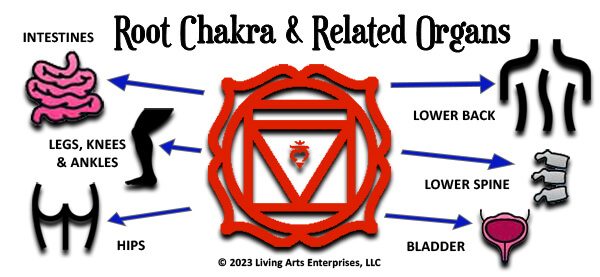
Root Chakra Organs: Feet
The feet represent the willingness to be on earth and engaged in life. This is literally a process of “putting your best foot forward.” In contrast with this attitude, someone who is afraid to rock the boat may be “walking on eggshells.” To have your feet firmly on the ground is to be willing to be on earth and walk your own path.
Spiritual Meaning of the Feet
Feet represent our “understanding” of life. Your feet are literally “standing under” your body. To put yourself under the tutelage of another is to be “at their feet.” For example, many religions refer to “sitting at the feet” of a spiritual master or deity.
The Soles of the Feet
The skin on soles of the feet is thickened to provide a barrier between the body and the exterior environment. The outermost layer of the epidermis is called the stratum corneum. These cells have lost most of their fluid and have been converted to protein. The thickness of this layer is determined by how much weight the skin bears and how much abrasion is present. A person who is “thick-skinned” is one who can handle a significant amount of abrasion or conflict.
Root Chakra Organs: Knees
On both the physiological and emotional levels, the knees are related to bending and flexibility. To “bend the knee” is to recognize the superior rank or knowledge of another. Problems with the knees can be connected to issues of pride and ego. Other causes of knee problems are stubbornness and the refusal to yield when necessary or advisable.
Psychological Meaning of the Knees
The knees are also related to personal “needs.” The left knee is closely related to the needs of the feminine side for both men and women. This could be the need to be appreciated and nurtured. The right knee is related to the masculine side. This might involve the need to be successful in society and to protect others.
Root Chakra Organs: Intestines
Some of the idioms and metaphors we use to refer to our intestines reveal our feelings about this root chakra organ. You get a “gut feeling” about something (intuition). You do a “gut check” before making a decision. You have a “gut instinct” about a person or situation.
More Intestinal Metaphors
A heart-breaking occurrence can also be referred to as “gut-wrenching.” If you are upset, you may “get your bowels in an uproar.” A person who is strong on all levels (especially psychologically) is said to have “intestinal fortitude.” This kind of strength reflects the ability to assimilate whatever life brings.
Spiritual Meaning of the Intestines
The function of the intestines is to absorb nutrition. As far as digestion is concerned, this is the final and most critical phase. On a spiritual level, this is akin to the ability to follow ideas and projects through to completion. You need to know when to process life and when to let go. The small intestine relates to holding onto details and trying to analyze information or experiences obsessively.
Root Chakra Organs: Bladder
The bladder is an amazing, flexible storage tank. The bladder wall contains three layers of smooth muscle. This pear-shaped organ can extend and shrink as needed. Clearly, the bladder is holding that which the body no longer needs. This is a perfect metaphor for the discernment needed to choose what to retain and what to release in life.
Emotions and the Bladder
When we are angry, we may say that we are “pissed off.” This is literally a reference to the fact that we have a situation where communication is needed! That may be an internal process or an external exchange. Holding onto situations, possessions or people that are no longer serving a positive purpose in your life can appear in the physical body as holding onto excess water or urine.
Root Chakra Organs: Pelvis
A broken or injured pelvis shows conflicts related to security, survival, relationships, and sexuality. These issues are directly related to the root chakra. Pelvis injuries can also be a fear of your own feelings. The pelvic girdle is actually made up of two hip bones that meet in the front of the body at the pubic symphysis. In the back of the body, the hip bones meet with the sacrum.
Pelvis and Organs of Elimination
The pelvis contains the organs of elimination and reproduction. The organs of elimination (bladder, colon, rectum) are the most closely connected to the root chakra. The organs of reproduction are more closely related to the second or sacral chakra.
Root Chakra and the Skeletal System
The skeleton serves as the framework and structure for our lives. We depend on the strength of our skeleton for everything we do. The skeleton represents security, safety, trust and belonging. For these reasons, the skeleton is associated with the root chakra.
Symbolism of the Skeletal System
The skeleton is the hardest and densest form of tissue in the human body. Therefore, the skeleton is connected to our deepest level of psychology, emotions, and spirituality. Breaking a bone or developing a bone disease is an opportunity to look at your core beliefs. This can include the deepest levels of your inner world and an examination of your very purpose and reason for existence.
Root Chakra and the Muscular System
The muscles are the first system in the body to react to stress. As muscles are tightened, movement is limited, and inflexibility results. When the basic survival needs connected to the root chakra (food, shelter, and acceptance) are not being met, chronic muscular tension can result.
The Root of Muscular Stress
Holding tense muscles can be a way to protect yourself. You may feel overwhelmed and out of control. Emotional paralysis and physical tenseness may go hand in hand. Addressing the core issues of the root chakra on all levels can help to release this tension.
Finding Release for the Muscular System
Prayer and meditation are helpful for centering. You may also want to take stock of your situation on a pragmatic level and look for practical solutions to attaining a higher level of security in your life. A new job, increased education or training, or relocation may be options to consider.
Chakra-Related Articles
SACRAL CHAKRA and Body Organs
Sacral chakra meaning is focused on relationships. This includes one’s relationship with oneself as well as others. The sacral chakra is known in Sanskrit as Svadhishthana, meaning literally “one’s own place.”
Sacral Chakra and Communication
The sacral chakra is the realm of communication, exchange, and finances. If this energy is used improperly, addiction to sex or gambling can result. As the center of reproductive ability, the sacral chakra is also the seat of artistic creation. Sometimes the sacral chakra is called the seat of the soul.
Seat of the Soul
The organs associated with the sacral chakra include the following:
- reproductive organs
- lower back
- hips
- kidneys
Sacral Chakra Organs: Reproduction
The process of reproduction allows us to pass on our genetic materials to future generations. The male and female reproductive organs produce special cells that unite to forma zygote. The zygote grows into an embryo, then a fetus, and finally a independent human being. Accordingly, the uterus in the female represents the home (womb) of creativity. This is a place of nurturing. The male reproductive organs hold the energy necessary to launch a new phase in life or propel a project forward.
Sacral Chakra and the Lower Back
The lower back is often connected to finances. Economic difficulties can result in tension and pain in the lower back. This can either be a fear of money or a lack of financial support. Feeling overwhelmed or under too much pressure can also cause lower back issues.
Finances and Energy Exchange
By and large, finances are a process of exchange. This may be services or products. This form of communication connects to the energetic role of the sacral chakra. Constant worry about paying bills will affect the lower back. Shifting your focus to how you can contribute to others and support yourself can help to reestablish the energy flow in the sacral chakra.
Sacral Chakra Organs: Kidneys
The kidneys are small but incredibly effective organs for filtering blood and keep the body in a state of homeostasis. The kidneys remove waste from the blood: urea, excess water, excess ions and toxic wastes. The kidneys also reabsorb needed substances to return them to the blood. This is a constant exchange to maintain and eliminate substances as needed for optimal health.
Source of Strength
The kidneys are located close to the sacral chakra on the back side of the body. They are viewed energetically as a source of great strength. In many cultures, the lower back and waist are wrapped in a special cloth during the colder months to keep the kidneys warm and support their function.
Sacral Chakra and the Body: Hips
The hips move us forward in life: finding one’s place and making the contribution to life that the soul desires. Problems with the hips or a broken hip can be caused by a loss of support or the desire to lean on someone else awhile. You may be resisting forward movement in life.
Celebrating Forward Movement
Interestingly, “Hip, hip, hooray!” is a common way to cheer for those who are successful moving forward in sports, life and business endeavors. Problems with the right hip are related to the masculine side of life or your relationships with men. Difficulty with the left hip is often connected to challenges in your relationships with women or feeling blocked by a feminine presence in your life.
Author’s Personal Story: “My own greatest awareness of the sacral chakra was during my first pregnancy. When I got married in my late twenties, I was not sure that I could have children at all. By the time I was thirty, I had been trying to get pregnant for three years.
I had gone through multiple types of fertility treatments. They were painful, inconvenient, expensive and unfruitful. Yet I had wanted a large family from early childhood. I was struggling with the heartache of thinking that the reality of a family might never come to pass. Still, my body was not responding well. I stopped pursuing the various treatments.
One morning a few months later, I was at work and suddenly felt such a tremendous joy, so distinct and remarkable that I called my husband to say, “I don’t know what just happened, but I feel incredibly happy!” I didn’t connect it at that moment to conceiving a child since conception often takes place one to two days after intimate relations. I remembered that deep sense of joy about ten days later when I found out that I was indeed pregnant.”
ADDITIONAL RESOURCES: Article on the Sacral Chakra covering symbolism, chakra sounds, essential oils, healing stones and deities associated with this chakra.
SOLAR PLEXUS CHAKRA and Body Organs
The solar plexus chakra governs the power of transformation and assimilation. The solar plexus chakra is the center of digestion of food on the physical level as well as the digestion of thoughts and emotions on the mental and emotional levels. The solar plexus is the fire center, often symbolized by the colors yellow or red and a sun-like image.
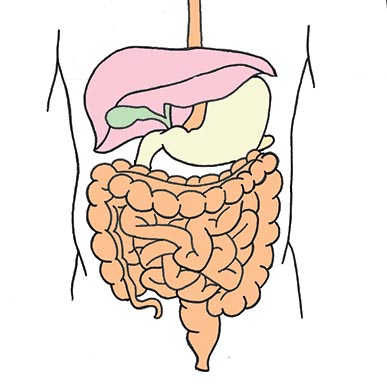
The solar plexus is the center of gut-level intuition. In the physical realm, the solar plexus is associated with the following organs:
- pancreas
- liver
- stomach
- adrenals
Solar Plexus Chakra Organs: Pancreas
The pancreas represents the ability to handle the sweetness in life. This is literally the ability to balance and process glucose in the body. The pancreas actually has a dual role. On the one hand, the pancreas produces pancreatic juice to aid in the digestion of food. On the other hand, the pancreas uses insulin and glucagon to balance the results of digestion as blood glucose levels. The pancreas is viewed as an endocrine gland because of the secretions it produces.
Solar Plexus Superpower
The conversion of negativity into advantageous emotions is a superpower of the solar plexus chakra. Having the attitude that the universe is always bringing you the highest possible good is helpful. Even challenges may bring a better outcome than expected or hoped for. You may want to ask yourself, “How can I shift my experience to feel to trust that there is a sweet outcome on the way?”
Solar Plexus Chakra Organs: Liver
The liver is one of the largest organs in the human body, weighing approximately four pounds. The liver has multiple functions crucial for human health. The liver manufactures proteins involved in blood clotting. Cells of the liver destroy certain bacteria and aged white and red blood cells. The liver contains enzymes that break down or store poisons. In addition, the liver stores nutrients, minerals, and vitamins. Finally, the liver produces bile salts that break down fats.
The Liver and Emotions
On an esoteric level, the liver has long been seen as the seat of anger and other primitive emotions. Liver problems can be related to chronic complaining and fault-finding. This may be a refusal to take full responsibility in your own life. Therefore, you are looking for ways to blame others. This is a misuse of the “solar” power of this chakra.
Solar Plexus Organs: Stomach
The stomach is simply an enlargement of the gastrointestinal tract. When empty, the stomach is only the size of a large sausage. However, when full, the stomach can be many times larger! The stomach is folded like an accordion which expands as the stomach fills. The stomach serves to break down food for assimilation. This is reflected on psychological and emotional levels as the ability to break down projects and ideas into consumable portions.
Solar Plexus Endocrine Glands: Adrenals
The adrenals help to regulate the level of energy in the body. They are responsible for the “fight or flight” mechanism when a situation appears to be dangerous or life-threatening. The adrenal glands are small glands found on top of the kidneys.
Hormones Produced by the Adrenal Glands
The adrenals produce epinephrine and small amounts or norepinephrine. These hormones break down glycogen from the liver to quickly increase heart rate and breathing. Blood flow is increased to the muscles to prepare for possible physical exertion. if the adrenals are overused, exhaustion and defeatism can result.
Author’s Personal Story: “I learned the importance of listening to my gut at a point in my life when I was collaborating with someone on a large creative project. My partner in the project appeared to have a commitment as deep as mine. I was excited and joyful about the project. Yet I simultaneously had a growing sense of anxiety at the core of my being. My heart and gut were clearly in conflict.
Sure enough, my associate suddenly and inexplicably changed directions. Communication stopped. My attempts to reach out were rebuffed. My investment of time, money and emotional energy were lost. I had to forge a new path forward alone. I had never experienced such a deep division within my own being: heart-felt enthusiasm combined with deep gut-level concern and warning. However, the next time I decided I would listen to my gut!”
ADDITIONAL RESOURCES: Article on the Solar Plexus Chakra covering symbolism, chakra sounds, essential oils, healing stones and deities associated with this chakra.
HEART CHAKRA and Body Organs
In the spiritual dimension, many traditions believe that the spark of life resides is an inner chamber associated with the heart. In the Western religious tradition, this inner chamber is called the inner castle or secret chamber of the heart.
Three-Fold Flame of the Heart
The spark is sometimes referred to as the three fold flame. This flame represents power (blue), wisdom (yellow) and love (pink). The fleur-de-lis is a symbol representing this three-in-one idea. Learn more about this symbol in the article Iris Flower Meaning.

Brahma’s Cave in the Heart Chakra
In the Eastern tradition, this inner heart is referred to as Brahma’s Cave. Again, this is a place where an eternal spark resides, unmoved by outer events. The ability to retreat into the inner chamber of the heart may be a critical skill in the fast-paced modern world.
Organs of the Body and the Heart Chakra
Traditions around the world place great importance on the significance of the heart. Many believe the heart has emotional significance as well as spiritual meaning. The physical organs associated with the heart chakra are the following:
- the heart itself
- circulatory system
- lungs
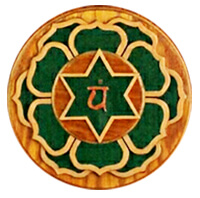
Heart Chakra Organs: The Physical Heart
The heart is made of fibrous connective tissue and muscle, divided into four chambers, that pump blood to the lungs and to the body. The heart is a carefully choreographed system of valves, arteries and veins that ensure oxygenated blood at all times. The heart also possesses and electrical conduction system to regulate the regular contractions for each cardiac cycle.
The Heart as a Second Brain
Some researchers believe that the heart has sensory functions as well as the mechanical function of pumping blood. Studies have shown that the heart reacts even more quickly than the brain to strong visual stimuli such as highly positive or negative visual images. The heart may be telling the brain to react rather than the other way around.
Heart Chakra as the Seat of Love
The heart has long been revered as the place of love and passionate ideals. We speak of “broken hearts” when relationships end or family and friends meet death. Our hearts are “burning” with devotion to a partner or to a spiritual teacher or mentor. There are depictions in many traditions of fire in the heart related to religious devotion. Clearly there is more than meets the eye!
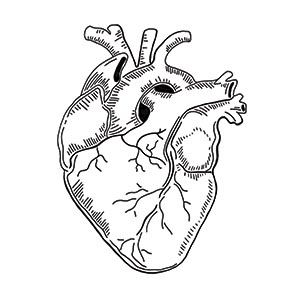
Heart Chakra Organs: Circulatory System
The circulatory system is composed of three branches: the systemic circulation (body), the pulmonary circulation (lungs), and the cerebral circulation (brain). Another temporary circulation system called the fetal circulation system exists temporarily in pregnant women.
Heart as a Spiritual Center in the Body
The circulatory system is a wonderful metaphor for the circulation of energy throughout the chakra system. The heart chakra is viewed as central in many traditions. There are three chakras below (root chakra, sacral chakra, and solar plexus chakra) and three chakras above the heart (throat chakra, third eye chakra, and crown chakra). The heart is often recommended as a focus for attention during spiritual practices including mantras.
Heart Chakra Organs: Lungs
The exchange of gases necessary for life takes place by diffusion across the alveoli and the capillary network in the lungs. Estimates are that the lungs contain over 300 million aveoli with a total surface area of 753 square feet (70 square meters). This provides a large surface for the exchange of oxygen and carbon dioxide.
Lungs and the Fire Breath
God is associated with the breath, fire and the wind in many traditions. The idea that God breathes life into animate form is also a common theme. In Christianity, the Holy Spirit is an undifferentiated power of God often referred to as a sacred breath. In Eastern traditions, the practice of pranayama (breath control) is integral to spiritual advancement.
ADDITIONAL RESOURCES: Article on the Heart Chakra covering symbolism, chakra sounds, essential oils, healing stones and deities associated with this chakra.
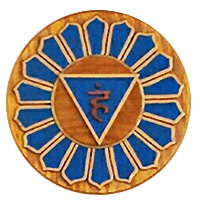
THROAT CHAKRA and Body Organs
There is a legend that goes as follows: when the human body was being created, God was trying to figure out where to put the power center so that His creations would not misuse this energy. So the power center was hidden in plain sight in the throat. Here we would qualify energy for blessing or bane with every word spoken. Thus, the throat is our greatest vulnerability and greatest strength.
Organs of the Body and the Throat Chakra
The physical organs associated with the throat chakra are the following:
- thyroid gland
- vocal chords
- trachea and esophagus
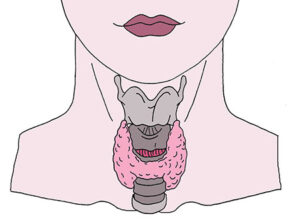
Throat Chakra Organs: Thyroid Gland
When I first began chanting, I had been on thyroid medication for over twenty years. Healing my thyroid took conscious effort on many levels…. Go to the Throat Chakra Symbol article to watch a video of the full story!
Throat Chakra Organs: Vocal Chords
The key voice apparatus is the area in the larynx called the vocal chords. The vocal chords are ligaments shaped like a “V”. These ligaments vibrate when we speak or sing. The vocal chords are about as long as the lines that would be required to draw a triangle on the front of a penny. The vocal chords also vibrate about the depth of the penny. On the psychological level, “losing your voice” may result from refusing to communicate, feelings powerless, or pushing yourself beyond your capacity.
Throat Chakra Organs: Trachea and Esophagus
The trachea is also called the windpipe. This tubular passage is the airway connecting the mouth with the lungs. The trachea is a combination of cartilage, muscles and elastic tissue. The esophagus is a collapsible, muscular tube behind the trachea. The esophagus transports food to the stomach. This is the organ that helps us to swallow our food. Problems with the esophagus can be related to “swallowing” grief, anger or hurt. Acid reflux (also known as “heartburn”) is a common disorder that affects the esophagus. Some studies suggest that more than 15 million Americans experience heartburn symptoms every day.
THIRD EYE CHAKRA and Body Organs
The pineal gland is the organ associated with the third eye chakra that receives the most attention. However, there are several organs associated with the third eye chakra. There is overlap for chakras that are close in vicinity: this is true for the third eye and crown chakras. The organs associated with the third eye all function to bring in sensation for interpretation by the brain. These organs include the following:
- pineal gland
- eyes
- ears
- endocrine system
Third Eye Chakra Organs: Pineal Gland
The name pineal comes from the Latin pinea or pinus, meaning pine cone. Representations of the pineal gland are used symbolically in art of the Sumerians, Egyptians, Indonesians, Greeks, Romans and Babylonians. Some traditions say that the soul enters and leaves the physical body at birth and death through the pineal gland.

Degeneration of the Pineal Gland
In most people, the degeneration of the pineal gland begins at the age of six or seven and continues until puberty. Some sources believe this is why children over the age of six or seven have a diminished ability to sense the spiritual world. They may no longer have “invisible playmates” or remember what happened “before they were born.”
Structure of the Pineal Gland
The interior of the pineal body contains follicles surrounded by connective tissue. The follicles consist of epithelial cells and calcareous deposits. In some reptiles the pineal gland serves as a light receptor. This connection may account for the serpent extended symbolically out of the forehead in the headdress of many Egyptian statues.
Third Eye Chakra Organs: Eyes
The eyes are the most mystical and emotion-laden organ in the body. The ability to see clearly is our most cherished sense. Accordingly, the eyes are deeply affected by our emotional and psychological world. On that level, problems with the eyes reflect the inability or fear of seeing what is in our world. Fear of the present can result in far-sightedness. Fear of the future can make us vulnerable to nearsightedness. When vision takes a turn for the worse, one or more traumatic events have likely preceded this change. Healing this trauma can positively affect vision.
Third Eye Chakra Organs: Ears
The ears not only allow us to access the world of sound around us, but also serve a crucial role in balance and equilibrium. The middle ear is air-filled and contains tiny bones that transfer vibrations to the fluid-filled inner ear. The ability to hear external noises is closely linked to the ability to hear one’s own inner voice. Turmoil or conflict around you can result in ear infections or other disturbances in the ability to hear.
Third Eye Chakra Organs: Endocrine System
The endocrine system produces hormones that control the internal environment of the body. This affects our health from the cellular to the organ level of organization. Hormones are crucial in growth, the development of sexual characteristics and behavioral regulation. Hormones operate primarily through a negative feedback loop, triggered by levels of the hormone in the body. The endocrine system consists of the hypothalamus, pituitary, pineal, thyroid, parathyroid, thymus, adrenal glands, pancreas and gonads. Managing your emotions is closely linked to this system.
ADDITIONAL RESOURCES: Article on the Third Eye Chakra covering symbolism, chakra sounds, essential oils, healing stones and deities associated with this chakra.

CROWN CHAKRA and Body Organs
The crown chakra is revered as the seat of enlightenment. This chakra is the thousand petaled lotus of wisdom in its myriad forms. There is some overlap between the organs associated with the third eye chakra and those associated with the crown chakra.
The energy of the crown chakra is usually represented as yellow or white. This is indicated in the halos around the heads of saints in Western iconography. In the east, the lotus is a revered symbol for the gentle opening of consciousness, petal by petal. On the physical level, the crown is generally related to the following organs:
- brain
- nervous system
- hair and skin
- hypothalamus
- pituitary gland
Crown Chakra Organs: The Brain
The brain has long been viewed as the seat of learning and intelligence. Studies now show that the brain retains elasticity far better than previously thought. Lifelong learning and exercise help to keep the brain functioning at an optimal level into the final decades of life. The brain is often viewed as a central control system like a switchboard or computer. However, recent studies show that our heart and gut also have a tremendous amount of neurons, functioning like secondary and tertiary brains.
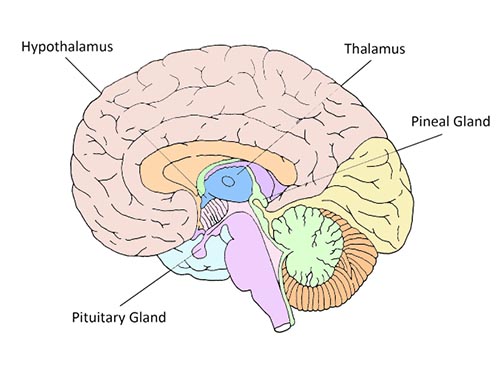
Crown Chakra Organs: Nervous System
The nervous system controls and integrates all of the other systems of the body. The nervous system consists of the brain, spinal cord, cranial nerves, peripheral nerves, and the sensory and motor structures of the body. The two major branches of the nervous system are the central nervous system and the peripheral nervous system. These are the physical paths of communication in the body. The nervous system is related to a whole host of conditions that are often hard to diagnose and hard to treat. The crown chakra can also be compromised by substances that affect consciousness such as psychedelics, prescription drugs, and environmental toxins.
Crown Chakra Organs: Hair and Skin
The hair, skin and nails are sensory organs as well as protective organs. There are also people who believe that human hair is an extension of the nervous system as well as an extension of the crown chakra. This is true in other species. Many mammals have whiskers that give them additional information about their environments. Hair also has cultural significance around the world.
Meaning of Hair in Ancient Cultures
For many cultures, long hair was a sign of courage and nobility. Cutting hair in some cultures meant cowardice, or mourning. Other cultures simply valued the way a man looked with a handsome complexion and long, dark hair. In Ancient Greece, long male hair was a symbol of wealth and power, while a shaven head was appropriate for a slave. Learn more in the article Body Symbolism.
Connection Between Hair and Physical Strength
In ancient China and Korea, hair was regarded as a precious legacy from parents. Most people would never cut their hair after they became adults and cutting off one’s hair was a penalty for minor crimes. In the Old Testament, the Nazirites would go for long periods of time without cutting their hair to show devotion to God. According to the Bible, Samson is one example. Samson’s strength depended upon his refraining from cutting his hair.
The Skin and Self-Identity
The skin is our clearest boundary between ourselves and the environment. Problems with the skin can be connected a lack of feeling safe in your own self-expression. The skin is often a concern during the teenage years when physical and hormonal shifts have a significant impact on the sense of self.
Crown Chakra Organs: Hypothalamus
The hypothalamus controls many functions related to homeostasis in the body. The hypothalamus works closely with the secretions from the pituitary gland. The hypothalamus receives sensory input from the body’s internal organs and controls the autonomic nervous system. The hypothalamus plays a key role as the intermediary between the nervous system and the endocrine system.
Crown Chakra Organs: Pituitary Gland
The pituitary gland secretes oxytocin and vasopressin. Oxytocin is the “bonding” hormone, present when a mother first nurses a newborn baby. Oxytocin is also released in positive social situations. The second type of hormones released by the anterior pituitary gland are growth hormones. The pituitary gland is referred to as the “master gland” because it controls the secretions of so many other glands.
ADDITIONAL RESOURCES: Article on the Crown Chakra covering symbolism, chakra sounds, essential oils, healing stones and deities associated with this chakra.
Author Kathleen Karlsen
Kathleen Karlsen is a musician, artist, writer and speaker. She is the author of two books (Flower Symbols and Vocal Medicine) and over 200 articles. Kathleen, her husband Andrew, and their five children live in Bozeman, Montana. More about Kathleen Karlsen.
More Chakra Resources
Chakras and Musical Notes: Chakras and musical notes have been paired in a number of ways. Learn about both Western and Eastern systems.
Chakra Names: Chakra names reveal the roles of the chakras in the body on psychological, spiritual and emotional levels. Includes explanations of English and Sanskrit chakra names.
Chakra Flowers: Chakra flowers offer unique symbolic meaning for each of the seven major chakras. Flowers are among the oldest spiritual symbols, revealing the meaning of each chakra.
CHAKRA AND ORGANS ARTICLE SUMMARY
This article covers the major organs associated with each of the seven chakras. The systems that correlate with each are delineated. The discussion of chakras and organs includes the human anatomy associated with elimination, reproduction, assimilation, circulation, communication, sensation and the nervous system. Links are given to additional resources for each of the chakras.

